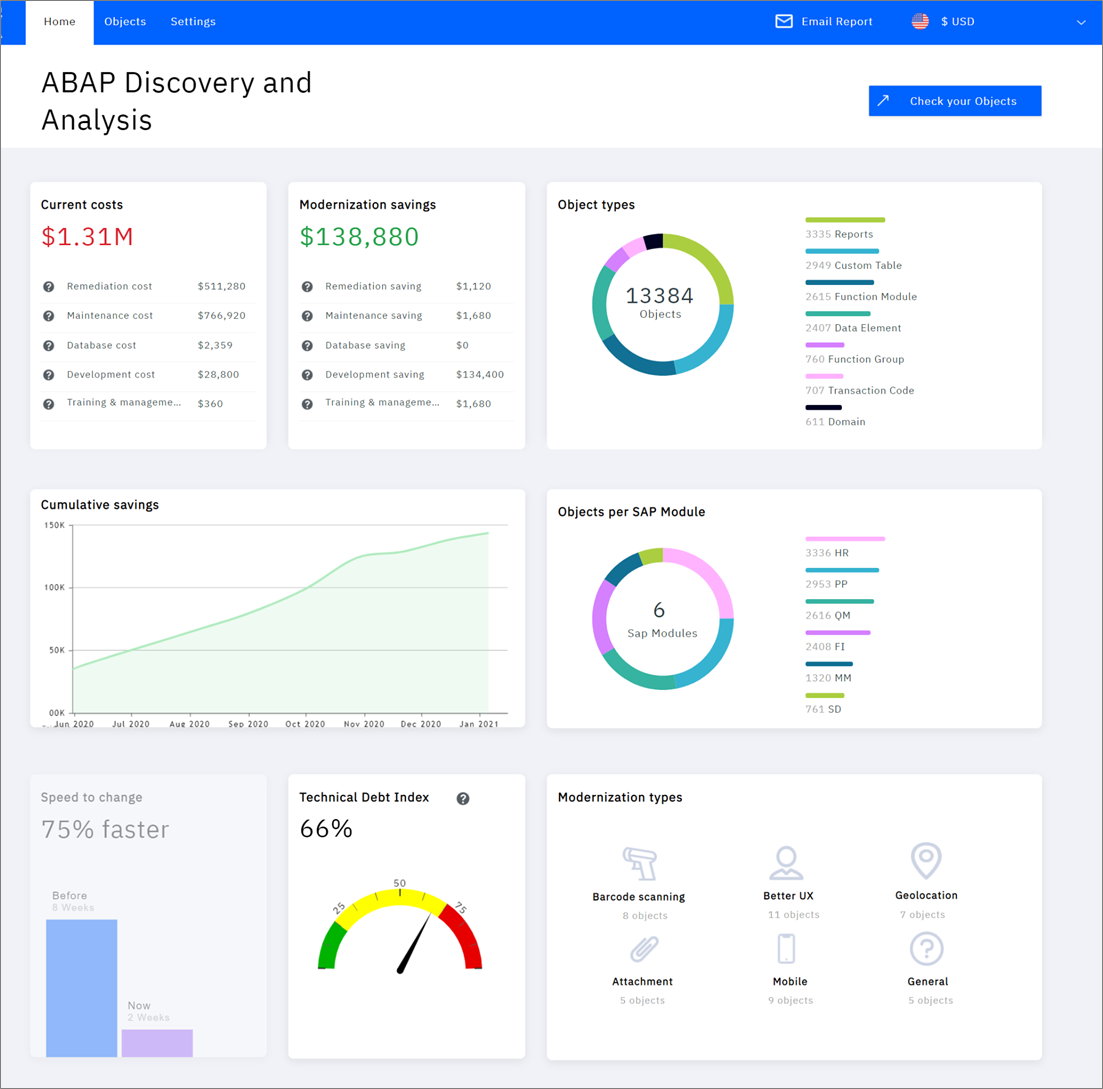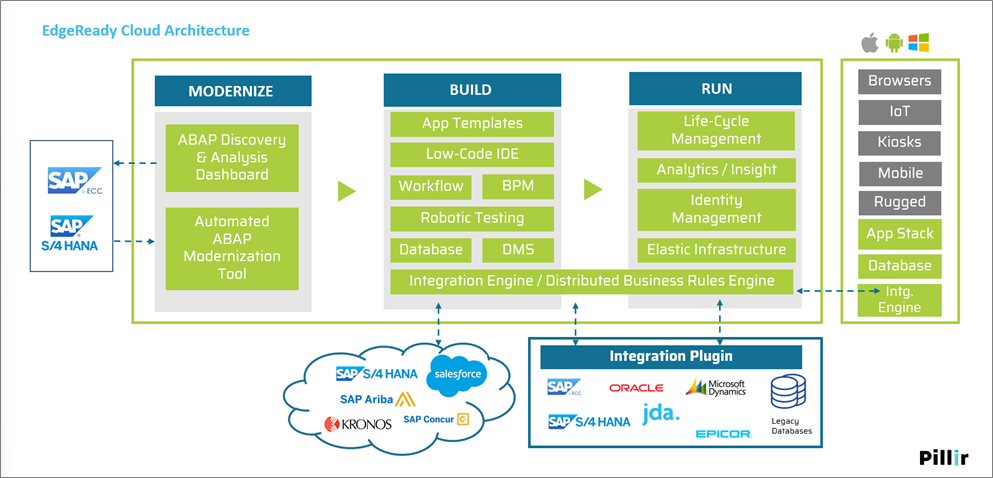AWS Partner Network (APN) Blog
How Rapid Application Development Affects Modernization for SAP Customers
By Irit Gillath, VP of Marketing – Pillir
By Chintan Sanghavi, Sr. Partner Solutions Architect – AWS
 |
| Pillir |
 |
Although migration to the cloud is well underway among SAP and other enterprise resource planning (ERP) users, as per a Forrester report more than 75% of enterprise organizations still utilize a certain amount of paper-based processes in their workflows. Close to 65% still run business processes on Excel.
The reason is obvious to CIOs—modernization is hard.
Complex ERP systems are not candidates for a lift-and-shift approach to cloud migration. In-house or outsourced developers must rework code to optimize it for a cloud environment. It takes time and resources, and in the final analysis it often does not generate much ROI.
Furthermore, an enterprise may not even have resources with expertise in cloud development or Advanced Business Application Programming (ABAP) language, SAP’s proprietary language modeled after COBOL from the 1980s.
The skills shortage, as well as the time and cost involved in brownfield projects, are leading many enterprises to conclude that the best course is to continue using their current ERP systems and the mission-critical customizations they rely on. The outcome, then, is to put off digital transformation a little bit longer.
Unfortunately, that means these businesses are also putting off providing their field sales or technicians with mobile access to ERP functionality and greater efficiency. They also forego the cost savings of retiring their data centers and innovation that could result in new products, services, and revenues when moving to the cloud.
There is a viable solution that can help enterprises advance their IT modernization plans right now. This post outlines how Pillir’s EdgeReady Cloud rapid application development platform hosted on Amazon Web Services (AWS) solves these problems for enterprises.
Pillir is an AWS Partner that gives developers an easy way to modernize legacy code and provide their operation the advantage of cloud-nativity, even if they don’t have cloud development expertise.
The ABAP Diagnostic Tool
Every cloud migration must be carefully planned to be successful and cost-effective. EdgeReady Cloud includes a diagnostic tool that allows development teams—and stakeholders throughout the organization—to visualize ABAP customizations and discover technical debt.
The tool automatically calculates the total cost of maintaining the custom code in SAP, as well as the cost of remediating the code. This allows teams to accurately calculate total cost of ownership (TCO) and make informed decisions about how to proceed with modernization.
Figure 1 – ABAP discovery and analysis dashboard.
The tool is purposefully designed so that any stakeholder—from the CIO and IT team to executives and managers with little technical expertise—can understand the extent of the enterprise’s technical debt. They can also work together to reach their goal of keeping the ERP core clean and minimizing total cost of ownership.
A recent survey by Pillir and the Americas SAP User Group (ASUG) found that 69% of businesses consider a clean core as important to maintaining their systems and simplifying future upgrades and extensibility. This ultimately keeps their organizations agile in a digital economy.
The ABAP Modernizer
Once a team understands the magnitude of the custom code cost and implications, they can prioritize those with the largest impact and start modernizing them one by one, at their own pace.
Pillir’s ABAP Modernizer provides developers with an easy way to move custom objects to the cloud. It automatically analyzes the business logic in the code, and converts it to modern, cloud-based mobile friendly applications.
Additionally, Pillir enables developers to retain complete control through the process. They have the opportunity to review the mapping in Pillir’s graphical interface to ensure it’s accurate and that it doesn’t contain any outdated or non-functional elements.
Developers can also refactor the application to optimize it for use in the new environment, such as taking advantage of cloud- or mobile-native features, or improving user experiences or the business process overall.
Figure 2 – Application process modeler.
Once the review is complete, Pillir’s platform does the heavy lifting to transform legacy custom objects to the cloud.
Furthermore, Pillir gives development teams the freedom to approach modernization in phases. It isn’t necessary to refactor all code at once, which is often required in large digital transformation projects. The team can work at the pace that makes the most sense based on their workloads and the enterprise’s activities as a whole.
Additionally, the work developers complete in the platform can help build a library of reusable components, such as base programming, logical steps, and frontend elements, which save time on future projects.
Connections and Integrations
Pillir is unique among low-code/no-code platforms. It was created specifically to solve the problem of modernizing legacy code, so in addition to making technical debt more visible and facilitating ABAP modernization, it also makes creating new applications, integration, testing, and deployment easier.
Whether an app on Pillir is the result of a greenfield or brownfield project, developers have the advantage of deep integration with SAP. Pillir doesn’t communicate with SAP through OData endpoints, which can be labor-intensive to create. Instead, Pillir provides direct access to SAP data through the EdgeReady SAP-certified plugin and OData is generated automatically.
Pillir also takes a low-code approach to integration with business processes. Pillir’s Integration Builder saves time and effort with graphical, drag-and-drop functionality, enabling developers to interact with backend systems and interface with the user interface (UI).
The Integration Builder features “building blocks” similar to Scratch, allowing quick integrations and business logic development.
Figure 3 – Integration Builder.
The Integration Builder also includes adapters for third-party software-as-a-service (SaaS) application integrations. This includes web-service adapters, REST service adapters, database adapters, and FTP adapters, and standardizing integrations.
Testing and Deployment
Digitally transforming processes often takes operations into somewhat uncharted territory. It isn’t always immediately obvious how an app should be deployed, whether as an iOS mobile-native app, embedded on a dedicated device, or as a progressive web app or hybrid.
All apps in Pillir—whether new or modernized legacy apps—are created using the same model, regardless of how the enterprise will deploy them. It isn’t necessary to decide in advance how developers will deploy the app, which some low-code or no-code platforms require.
Likewise, Pillir automates testing across a wide range of devices and network providers and simulates real-world scenarios for mission-critical applications. Pillir’s testing tool also reduces time typically spent on user acceptance testing (UAT), testing cycles, and regression cycles.
By removing complexity from connections, integrations, testing and deployment, Pillir further reduces costs and risks associated with ABAP modernization, keeping TCO low and improving speed to market.
Figure 4 – Logical architecture.
The Way Forward
Undoubtedly, it’s a tall order for a business to migrate to a new ERP platform, transition to the cloud, and adopt new agile development processes concurrently.
An enterprise rapid application development platform built on AWS that manages cloud services and takes the complexity out of ABAP modernization makes those changes much easier.
It also gives businesses additional advantages, including:
- Modernizing legacy code more quickly, typically moving from design to deployment in less than half the time as with traditional development processes.
- Completing projects with less demand for developers skilled in ABAP and cloud.
- Enabling stakeholders across the organization to solve problems, participate in decision-making, and even model and design apps via graphical, low-code/no-code interfaces.
- Enhancing visibility into app modernization for the development team as well as business leadership.
Conclusion
Pillir’s EdgeReady Cloud is designed for ABAP modernization and deep integration with SAP to help break down barriers to innovation.
Enterprises can move forward with plans to create new revenue streams via cloud services, improve product quality, optimize processes for greater competitiveness, or attain any other business goal that digital transformation can support.
Because the costs of legacy code modernization are decreased by using a purpose-built low-code platform on AWS, enterprises can see digital transformation ROI more quickly and lower TCO.
With barriers to custom code modernization out of the way, the only question left to answer is whether enterprises can afford not to move when transformation is a viable option and goals of greater competitiveness, profitability, and innovation are within reach.
Have an SAP-based business function you want to build or rebuild? Let Pillir show it to you live.
Pillir – AWS Partner Spotlight
Pillir is an AWS Partner that gives developers an easy way to modernize legacy code and provide their operation the advantage of cloud-nativity, even if they don’t have cloud development expertise.
Contact Pillir | Partner Overview | AWS Marketplace
*Already worked with Pillir? Rate the Partner
*To review an AWS Partner, you must be a customer that has worked with them directly on a project.




